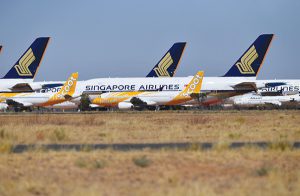Singapore Airlines Ltd’s long-delayed flight to India may finally be ready for takeoff.
As travel resumes and the carrier moves past the record annual loss it was reporting around this time last year, Chief Executive Officer Goh Choon Phong wants to pursue a multi-hub strategy, one in which airlines owned by it will benefit from aviation demand outside of Singapore. “India is obviously a very important one because
it’s going to be massive,†Goh told Bloomberg News, adding that he expects the country to be the third-largest aviation market after China and the US by the middle of the decade, if not sooner.
It’s a market that has attracted the small Asian city-state for decades. Singapore Airlines had partnered with the Mumbai-based conglomerate Tata Group in the failed 2001 privatisation of Air India Ltd. New Delhi finally got around to selling the flag carrier to Tata only last year. The company has often expressed its keenness to buy a stake in IndiGo, India’s biggest airline.
The Tata Group flirted with others, including Singapore Airlines’ arch rival AirAsia Bhd, with which it launched AirAsia India. Goh, who rose to become CEO in 2011, stuck to Tata, taking a 49% stake in its full-service carrier Vistara. In the seven years that Vistara has been flying, it’s yet to turn a profit even though it now serves nine overseas destinations and covers 31 cities in India.
But Goh’s loyalty and patience may finally be rewarded: Campbell Wilson, the CEO of Singapore Airlines’ no-frills Scoot brand, is joining as CEO of the newly privatised Air India. This isn’t a case of Tata poaching senior talent from its partner, but rather the beginning of a deeper relationship. Wilson’s move — plus the Tata Group’s plan to lease 700,000 square feet of commercial space near the New Delhi airport to house the corporate offices of Air India, its low-cost subsidiary Air India Express as well as Vistara and AirAsia India — prompted The Morning Context to ask if a merger was on its way. The news website had previously reported that Singapore Airlines and the Indian conglomerate had agreed to keep Vistara and Air India separate for two years. That timeframe to decide on a big, fat, Indian wedding may no longer be sacrosanct, it said.
For the salt-to-software Tata Group, consolidation of its airline businesses
will mean cost efficiencies, for instance, by removing overlapping routes and perhaps losing the AirAsia brand along the way.
Meanwhile, a substantial stake in Air India will be the jewel in Singapore Airlines’ crown. Its home base in Singapore is well-suited as a router of international passenger flows between India and the US west coast.
Vistara, which has already started some European routes, plans direct flights to the US as well, effectively giving Singapore Airlines a foothold in the lucrative West-bound market from India. If the New Zealand-born Wilson, a Singapore Airlines veteran, can pull off an Air India-Vistara integration, Goh can use the template to roll out his multi-hub strategy in other markets. Hopefully, those efforts won’t drag on for two decades. Or else they may have to be concluded by the successor to the 58-year-old CEO.
—Bloomberg
 The Gulf Time Newspaper One of the finest business newspapers in the UAE brought to you by our professional writers and editors.
The Gulf Time Newspaper One of the finest business newspapers in the UAE brought to you by our professional writers and editors.
